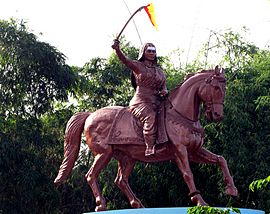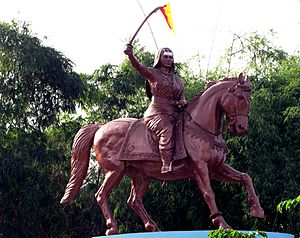Kittur Chennamma facts for kids
Quick facts for kids
Kittur Rani Chennamma
|
|
|---|---|

Statue of Rani Chennamma in Bengaluru
|
|
| Born |
Chennamma
23 October 1778 Kakati, Belagavi District, present day Karnataka, India
|
| Died | 21 February 1829 (aged 50) Bailhongal, Bombay Presidency, Company Raj
|
| Nationality | Indian |
| Other names | Rani Chennamma, Kittur Rani Chennamma |
| Known for | 1825 Revolt against the British East India Company |
Kittur Chennamma (born October 23, 1778 – died February 21, 1829) was a brave Indian Queen. She ruled Kittur, which was a small kingdom in what is now Karnataka, India. She is famous for leading a fight against the British East India Company in 1824. She wanted to keep her kingdom free from British control. Rani Chennamma won the first battle against the British. However, she was captured after a second fight and died as a prisoner of war. She was one of the first female rulers to lead her forces against the British. Today, she is remembered as a folk hero in Karnataka. She is also an important symbol of India's fight for freedom.
Early Life of a Queen
Kittur Chennamma was born on October 23, 1778. Her birthplace was Kakati, a small village in the Belagavi District of Karnataka, India. She belonged to the Lingayat Panchamasaali community. From a young age, she learned important skills. She was trained in horse riding, sword fighting, and archery. When she was 15, she married Raja Mallasarja of the Desai family.
Fighting for Freedom
Rani Chennamma's husband died in 1816. This left her with a young son and a kingdom facing many challenges. Sadly, her son also died in 1824. This meant Rani Chennamma was left to protect Kittur's independence. After her son's death, she adopted a boy named Shivalingappa in 1824. She made him the next ruler of Kittur.
The British East India Company did not like this. They had a rule that said if a ruler died without their own child, their kingdom would become part of British India. This rule was later called the Doctrine of lapse. The British ordered Shivalingappa to be removed. They told Kittur to accept British control.
Rani Chennamma wrote a letter to Mountstuart Elphinstone, a British leader. She asked him to let her keep her adopted son as ruler. But her request was refused, and war began.
The British gathered a large army to fight. They also guarded Kittur's treasury and royal jewels. In October 1824, the first battle took place. The British forces suffered heavy losses. St John Thackeray, a British officer, was killed. Amatur Balappa, one of Chennamma's lieutenants, was key to this victory. Two British officers were also captured.
Rani Chennamma released the captured officers. She hoped this would end the war. But the British leader, Mr. Chaplin, continued fighting with more soldiers. In the second attack, another British officer, Munro, was killed. Rani Chennamma fought bravely with her deputy, Sangolli Rayanna. However, she was eventually captured. She was imprisoned at Bailhongal Fort. Rani Chennamma died there on February 21, 1829, due to poor health.
Sangolli Rayanna continued fighting the British. He used guerrilla warfare, which means surprise attacks. He wanted to make Shivalingappa the ruler of Kittur. But Rayanna was also caught and hanged. Shivalingappa was arrested by the British too.
Rani Chennamma's bravery and her first victory are still celebrated. Every year, the Kittur Utsava festival is held from October 22-24. It remembers her fight for freedom.
Memorials
Burial Place
Rani Chennamma's burial place, called a samadhi, is in Bailhongal.
Statues
- Parliament House, New Delhi
On September 11, 2007, a statue of Rani Chennamma was unveiled. It is located at the Indian Parliament Complex in New Delhi. Pratibha Patil, India's first woman President, unveiled the statue. Many important leaders were there, showing the statue's importance. The statue was a gift from the Kittur Rani Chennamma Memorial Committee. It was sculpted by Vijay Gaur.
- Other Statues
There are also statues honoring Rani Chennamma in other cities. You can find them in Bengaluru, Belagavi, Kittur, and Hubballi.


